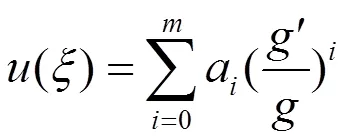(2+1)维破裂孤子方程组的精确解
王振立,刘希强
(2+1)维破裂孤子方程组的精确解
王振立,*刘希强
(聊城大学数学科学学院,山东,聊城 252059)
利用推广的()展开法,并借助于计算机代数系统maple,获得了(2+l)维破裂孤子方程组新的显式解,包括单循环孤立子解、三角周期解、有理函数解等。
(2+1)维破裂孤子方程组;()展开法;显式解;齐次平衡
寻找非线性偏微分方程的精确解在孤立子理论中一直占有重要地位。非线性偏微分方程描述了众多领域的复杂现象,如物理学,生物,化学,工程等。到目前为止已发展了许多不同的求解方法,如Painlevé截尾展开法[1],双曲函数法[2-4],Jacobi椭圆函数展开法[5],Jacobi椭圆函数方法一般化的F-展开法[6],反散射法[7],齐次平衡法[8]等。利用这些方法得到许多丰富的精确解,包括孤立波解,周期波解等。
文献[9]中提出了一种新的构造精确行波解()的展开方法。该法的主要思想是:非线性演化方程的行波解可以表示为()的多项式,多项式的次数可由齐次平衡原则确定;多项式的系数可通过解一个非线性代数方程组求得;非线性代数方程组是应用()展开法过程中产生的。该方法具有直接、简洁与基本的优点,已有效地求解了许多非线性演化方程。本文应用()展开法获得了(2+1)维破裂孤子方程组含任意参数的更多的显式行波解。
1 (w/g)展开法
考虑如下偏微分方程


(ii)假设(1.2)有下述形式的解:
(1.3)
关于()的项共有+1项。这里的()满足以下方程

即


且满足


这是我们熟悉的tanh函数展开法[11-12]。

且满足


且满足


2 (2+1)维破裂孤子方程组的行波解
考虑以下方程组



将(2.4)积分一次得

代入(2.3)式积分并置积分常数为零,得




解以上代数方程组得:





解以上代数方程组得:
注:(1)本文得到方程组显式解比文献[13]中的该类型的解丰富。
(2)本文得到的解均经过maple数学软件检验。
3 结论
()展开法的提出为非线性发展方程(组)的求解又提供了一种强有力的办法。本文将简洁的()展开方法应用于(2+1)维破裂孤子方程组的显式行波解,其中包括孤立波解、三角函数解以及有理函数解。由于参数的任意性, ()展开法可以获得(2+1)维破裂孤子方程组更多的精确解。这些精确解对解释复杂的物理现象有重要的作用。()展开法具有直接、简捷而基本的优点,该方法具有一定的普遍性,可以用来求解其它的非线性发展方程(组)。
[1] Weiss J,Tabor M, Carnevale G . The Painlevé property for partial differential equations[J]. Journal of Mathematical Physics, 1983, 24(3): 522-526.
[2] Parkes E J, Duffy B R. An automated tanh-function method for finding solitary wave solutions to non-linear evolution equations[J]. Computer Physics Communications, 1996, 98(3): 288-300.
[3] Abdusalam Η A. On an improved complex tanh-function method[J]. International Journal of Nonlinear Sciences and Numerical Simulation, 2005, 6(2): 99-106.
[4] Fan E. An algebraic method for finding a series of exact solutions to integrable and nonintegrable nonlinear evolution equations[J]. Journal of Physics A: Mathematical and General, 2003, 36(25): 7009-7016.
[5] Liu S, Fu Z, Liu S, et al. Jacobi elliptic function expansion method and periodic wave solutions of nonlinear wave equations[J]. Physics Letters A, 2001, 289(1): 69-74.
[6] Zhou Y, Wang M, Wang Y. Periodic wave solutions to a coupled KdV equations with variable coefficients[J]. Physics Letters A, 2003, 308(1): 31-36.
[7] Ablowitz M J, Segur H. Solitons and the inverse scattering transform[M]. Philadelphia: Siam, 1981.
[8] Fan E, Zhang H. A note on the homogeneous balance method[J]. Physics Letters A, 1998, 246(5): 403-406.
[9] Li W A, Chen H, Zhang G C. The (ω/g)-expansion method and its application to Vakhnenko equation[J]. Chinese Physics B, 2009, 18(2): 400-404.
[10] Wang M L, Li X, Zhang J.The(′/) -expansion method and travelling wave solutions of nonlinear evolution equations in mathematical physics[J].Physics Letters A,2008, 372(4):417-423.
[11] Fan E. Extended tanh-function method and its applications to nonlinear equations[J]. Physics Letters A, 2000, 277(4):212-218.
[12] Wazwaz A. Exact solutions for the ZK-MEW equation by using the tanh and sine–cosine methods[J]. International Journal of Computer Mathematics, 2005, 82(6): 699-708.
[13] Cao R. Exact Solutions for (2+1) Dimensional Breaking Soliton Equation[J]. University mathematics, 2012, 28(2):34-36.
Explicit Solutions of (2+1)-dimensional Breaking Solition Equations
Wangzhen-li,*LiuXi-qiang
(College of Mathematical Sciences,Liaocheng University, Liaocheng, Shandong 252059,China)
Applying the generalized () -expansion method and with the help of computer algebraic system maple, the explicit travelling solutions of the (2+1)-dimensional breaking solition equations were obtained, which included soliton solution, the trigonometric functions and the rational functions.
(2+1)-dimensional breaking solition equations; the ()-expansion method; explicit solutions; homogeneous balance principle
O175.2
A
10.3969/j.issn.1674-8085.2014.04.005
2014-03-28;
2014-05-15
国家自然科学基金和中国工程物理研究院联合基金项目(11076015)
王振立(1981- ),男,山东枣庄人,硕士生,主要从事非线性偏微分方程解的研究(E-mail: wzl2319668@163.com);
*刘希强(1957- ),男,山东菏泽人,教授,博士,主要从事非线性偏微分方程系统研究(E-mail:liuxiq@sina.com).

